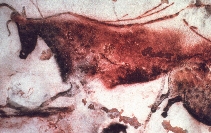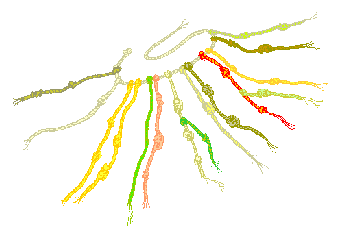- HOME
- VISIT
- ABOUT
- TOURS
- VISITOR FAQs
- LOCAL RESOURCES
- FAST FACTS
- MOAH HISTORY
- WILLIAMS HOUSE
- VICTORY GARDEN
- BOARD AND STAFF
- EXHIBITS
- CURRENT EXHIBIT
- PERMANENT EXHIBITS
- FUTURE EXHIBITS
- PAST EXHIBITS
- ARCHIVED EXHIBITS
- COLLECTION
- COLLECTION HISTORY
- DONATE TO THE COLLECTION
- SEARCH COLLECTION
- PROGRAMS & EVENTS
- CALENDAR
- ADULT PROGRAMS
- CHILDREN'S PROGRAMS
- ANNUAL EVENTS
- PAST EVENTS
- SPECIAL EVENTS
- GET INVOLVED
- MEMBERSHIP
- VOLUNTEER
- GIFT OPPORTUNITIES
- STAY CONNECTED
- EMAIL SIGNUP
- NEWSLETTERS
- PRESS
- Membership Response
Ancient forms of data storage
Notched sticks, knotted animal hair, scribed or incised tablets, carved or incised bones and shells, painted or scraped rocks -- all were media for the storage of information. Among the earliest known forms of data storage are the images carved in stone or
painted upon the walls of caves. This Lascaux cave painting, suprisingly sophisticated
and appealing to modern tastes, is believed to be about 20,000 years old.
Among the earliest known forms of data storage are the images carved in stone or
painted upon the walls of caves. This Lascaux cave painting, suprisingly sophisticated
and appealing to modern tastes, is believed to be about 20,000 years old.
Pictographic images gradually became more abstract and evolved into alphabets prior to historical times. It could be argued that the invention of alphabets was a necessary condition for the existence of recorded history.
Alphabet
When people first began to write, they did not use an alphabet. Instead, they drew small pictures to represent the objects they were writing about. This is called picture writing, and it was very slow because there was a different picture for every word. Egyptian Hieroglyphics are an example of a highly developed form of picture writing.An alphabet does not contain pictures. Instead, it is a collection of letters or symbols that represent sounds. Each sound is just part of one word. Joining the letters together forms a whole word. The human voice can make 35 different sounds in speech. So alphabets need at most 35 letters to write any word, and most alphabets manage with fewer.
The Phoenicians, who lived about 3,000 years ago in the Middle Eastern country now called Syria, developed the first modern alphabet. The ancient Greeks adapted the first modern alphabet, and later the Romans improved it. The Roman alphabet is now used widely throughout the world. Arabic, Hebrew, Sanskrit and many other alphabets are also in current use. Most have ancient origins.
Cuneiform
 About 5,000 years ago in Mesopotamia (now part of Iraq), a form of writing called
cuneiform developed. It started off as picture writing, but later letters began to
represent sounds. The Mesopotamians did not have paper; instead they wrote on damp
clay tablets using wedge-shaped pens. Cuneiform means "wedge-shaped".
About 5,000 years ago in Mesopotamia (now part of Iraq), a form of writing called
cuneiform developed. It started off as picture writing, but later letters began to
represent sounds. The Mesopotamians did not have paper; instead they wrote on damp
clay tablets using wedge-shaped pens. Cuneiform means "wedge-shaped".
The clay tablets usually contained adminstrative or commercial records. Tablets might have accompanied caravan shipments as cargo manifests, for instance. Others contained legal codes or medical information.
Chinese pictograms
 In traditional Chinese writing (Kanji), symbols called pictograms are used to represent
ideas. There is a different character for every word. The example shown here means "sun".
A person with a basic education must know about 2,000 Kanji characters. A well-educated
person will know about 20,000 characters. Kanji migrated to Japan and Korea, spread by
travelers, scholars, traders and invaders, with some changes, additions and
simplifications made along the way. Early forms of Kanji characters have been found
inscribed upon bones and turtle shells. These inscribed objects are thought to have
been used to fortell the future.
In traditional Chinese writing (Kanji), symbols called pictograms are used to represent
ideas. There is a different character for every word. The example shown here means "sun".
A person with a basic education must know about 2,000 Kanji characters. A well-educated
person will know about 20,000 characters. Kanji migrated to Japan and Korea, spread by
travelers, scholars, traders and invaders, with some changes, additions and
simplifications made along the way. Early forms of Kanji characters have been found
inscribed upon bones and turtle shells. These inscribed objects are thought to have
been used to fortell the future.
Storage by design
The ancients also stored certain kinds of information in the design of objects. Temples were often designed to serve as astronomical observatories, with design elements placed to mark key events, such as the summer and winter solstice, and the spring and fall equinox.
Object design continued to be a way of storing information into modern times: Consider the slide rule (stores tables of logarithms), the sundial (stores astronomical data), the abacus, and any number of mechanical measuring instruments. In the 1930s and 1940s, mathematical computations were performed using cams and other mechanical parts formed into shapes representing mathematical functions. Electronic analog computers are descendants of these analog mechanical calculators.
Quipu
 The quipu is an assembly of colored knotted cotton cords used by the ancient Inca as a
data storage device. Cord color, manner of connection, relative placement, cord
spacing, the types and placement of knots on individual cords, are elements of the
recording code. The quipu has a horizontal main cord to which several hanging cords
are attached. Knots are tied in the hanging cords at regular intervals. The shape of
the knot indicates numeric value (1, 2, 3, etc.), while distance from the main cord
indicates place value (ones, tens, hundreds, etc.). The color of the cord might
indicate the kind of person or object represented.
The quipu is an assembly of colored knotted cotton cords used by the ancient Inca as a
data storage device. Cord color, manner of connection, relative placement, cord
spacing, the types and placement of knots on individual cords, are elements of the
recording code. The quipu has a horizontal main cord to which several hanging cords
are attached. Knots are tied in the hanging cords at regular intervals. The shape of
the knot indicates numeric value (1, 2, 3, etc.), while distance from the main cord
indicates place value (ones, tens, hundreds, etc.). The color of the cord might
indicate the kind of person or object represented.
Methodical, the highly organized Inca were concerned with detail and, therefore, intensive data users. Inca bureaucracy continuously monitored areas under its control, receiving and sending many messages daily. Typical messages requisitioned resources, inventoried warehouses, recorded taxes owed or collected, tallied census data, the output of mines or the composition of work forces. Messages were transmitted by runners using an extensive road system . The Quipucamayu (quipu-maker) was a specialist, responsible for encoding and decoding the information, and could be considered the telegrapher of that time. The quipu could be considered an ancient ancestor of the floppy disk - removable, widely used and easily transmitted between locations.

|
This page
last updated: May 6, 2010 Original content: Copyright © 2000, 2001, 2002-2010 Museum of American Heritage Trademarks are the property of their owners |
 |
Join today! Membership dues help sustain MOAH. For more information and to download a Membership Form
LEARN MORE HERE
For questions and comments
Contact Us.
Mailing Address
PO Box 1731, Palo Alto, CA 94302
351 Homer Avenue
Palo Alto, California
p. 650.321.1004
e.



